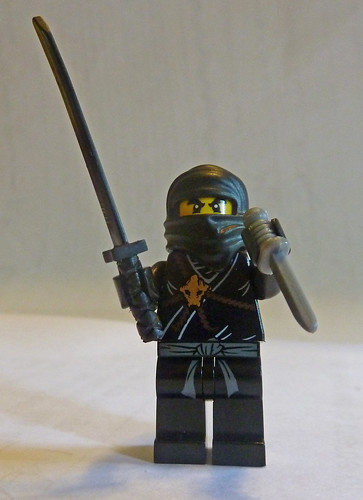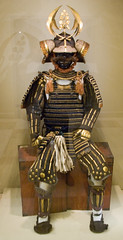The ninja question came up last week in my Samurai class — we were talking about possible writing projects — so I had to do my ninja spiel, which has become a bit of a set piece. The history of ninja in three stages: Sneaky samurai, literary device, and school.
The first stage covers the history up through the Warring States, possibly including the early Tokugawa, and it’s the age when, as Karl Friday put it, ““ninja” denotes a function, not a special kind of warrior–ninja WERE samurai … performing “ninja” work.” Turnbull describes this period in some detail, and it’s fairly clear from his collected episodes that there may have been some warriors who were especially sneaky, but not a continual tradition. There are a variety of figures that are credited as “the first ninja”: I’m partial to the yamabushi theory, just because it does highlight the warrior-priest tradition, and because it attributes to the ninja magical powers and ethical principles which are clearly absurd. Ignoring, though, the origins snipe-hunt, there clearly was a place for stealth, surprise and spycraft in the free-for-all conflicts of Japan’s warrior ages, when samurai honor was based more on “victory or death” than battlefield procedure.1 So some warriors did that. 
As the Hideyoshi-Tokugawa peace takes hold, and Samurai become a more cohesive class with an interest in Confucian ethics, a more rule-oriented value system,2 they become ashamed of the sneaky successes of their predecessors, and also start to become more specialized and formalized with regard to combat styles. Most schools of martial arts have both public and secret teachings, so the idea of a separate class of stealth specialists with secret traditions is entirely consistent with the Tokugawa-era samurai tradition. This is where the second stage begins: the cultural ninja.
Ninja were a lively part of the Tokugawa entertainment industrial complex: plays, fun houses, books, and visual art all explored the idea of the secret warrior, turning him in to a mighty, nearly mystical, foe, a haunting presence which could only be beaten through preparedness and righteousness by the mightiest samurai.3 Ninja become Robin Hood/Jesse James type outlaws, a friend to the common man — sometimes said to be of peasant origin themselves — and a blight on the establishment. By being a kind of anti-hero, occupying a rhetorical tactical space that the samurai could not, the ninja helped to legitimate the samurai as ethical warriors, as well as providing a kind of outlet for anti-samurai frustration and fantasy. This version of the ninja enters the western literary tradition through, among others, Ian Fleming’s James Bond novels.4 This stage is still very much in existence, of course, as the literary/cinematic tradition persists, even adding new themes like environmental consciousness.
 The third stage overlaps the second — a common problem for historians attempting stage theories; perhaps ‘state’ or ‘thread’ would be a better unit — from the early modern to the modern. At some point in the Tokugawa or Meiji eras, depending on the form and who you believe, styles of martial arts became formalized more or less at the same time that they become largely irrelevant. As noted above, most have some form of “secret teaching” for advanced adepts, and a “hidden history” as well tracing back to a noteworthy ancestor-teacher, and most of them also have well-established rivalries with related schools. In that regard, Ninja as a modern “warrior way” isn’t distinguishable from other Japanese or Chinese martial practices. In the modern age, when combat techniques are as much a matter of market forces and fashions as military necessities, the secret traditions have largely become routinized; the mythology of the ninja requires an overlay of mystery, which is maintained both by the continuing use of ninja legends as entertainment5 and a passionate defense of the narrative of ninja as a secret, continuing tradition which has emerged into the light with modernity.
The third stage overlaps the second — a common problem for historians attempting stage theories; perhaps ‘state’ or ‘thread’ would be a better unit — from the early modern to the modern. At some point in the Tokugawa or Meiji eras, depending on the form and who you believe, styles of martial arts became formalized more or less at the same time that they become largely irrelevant. As noted above, most have some form of “secret teaching” for advanced adepts, and a “hidden history” as well tracing back to a noteworthy ancestor-teacher, and most of them also have well-established rivalries with related schools. In that regard, Ninja as a modern “warrior way” isn’t distinguishable from other Japanese or Chinese martial practices. In the modern age, when combat techniques are as much a matter of market forces and fashions as military necessities, the secret traditions have largely become routinized; the mythology of the ninja requires an overlay of mystery, which is maintained both by the continuing use of ninja legends as entertainment5 and a passionate defense of the narrative of ninja as a secret, continuing tradition which has emerged into the light with modernity.
These three phases of the ninja tradition help separate out the fact from the fiction, clarify how and why ninja might be a substantial historical topic, and why the entertainment tradition has strayed so far from anything resembling reality.
see Conlan, State of War, which we’ll be reading in a few weeks. ↩
see Ikegami, The Taming of the Samurai, which we’re reading now ↩
There’s a whole history yet to be written on the relationship between US military presences in East Asia, kung fu movies and the rise of Japanese martial arts in the US. But nobody’s written it yet. ↩
From children’s literature to Mito Komon…. ↩
Hi Dr. Dresner,
My name is Clay Greeley. I am a student of Dr. Hofmann. I am writing a research paper on samurai and want to look at the status of samurai in society and how that has changed over time. She suggested I look to see if there are translations of laws and edicts form two different periods. I was wondering if you know of any relevant documents that would be useful in my research.
Thank you for your time,
Clay
Hi, Clay,
There’s quite a bit of Japanese law in translation, at least in fragments, but if you’re topic is the role of samurai in society as a whole, it could be challenging: most of the law codes I can think of are either general codes of law for everyone but samurai, or internal samurai class laws, from which you’ll have an interesting challenge piecing together their larger roles.
Your best starting place to get an idea of the scope of what’s out there would be one (or more) of the collections of Japanese sources. David Lu’s Japan: A Documentary History has nice clear context sections and a strong legal focus. The Columbia UP collections, Sources of Japanese Tradition also have a lot of political material; the older editions are available through the ACLS e-book collection, if you have access to it; the newer editions are much larger, though I haven’t looked at them with legal history in mind. There are a few other specific translations I’ll mention below.
The earliest samurai-related code I can think of is the 1232 Goseibai Shikimoku, which is mostly a guide to dispute settlement. There’s a great collection of translated Muromachi-era laws by Ken Grossberg that I think is a fascinating resource. In the 1500s there are a number of samurai “house codes” for individual domains which survived, many of which are included or excerpted in the collections. The 1615 Buke Shohatto is the foundational code for the Tokugawa peace, though only a small starting place for the laws of the time. There’s a neat book for that period The Status system and social organization of Satsuma:
a translation of the Shūmon tefuda aratame jōmoku by Torao Haraguchi, but it may be hard to find: I own a copy, but it’s not widely available. Which is too bad: Satsuma is interesting, but not terribly normal for that period.
There are other books on law, and Jeffrey Mass, in particular, has translated substantial collections of documents for the Kamakura era which relate to law, property, leadership, etc.
Good luck!